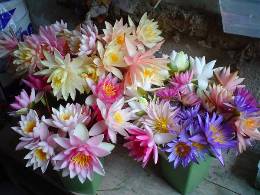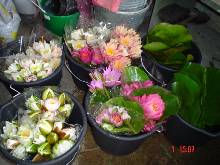|
Christian Meyer is a waterlily grower and hybridizer
in Germany who specializes in cut flowers for the trade. In the
flowering season, he and his crew pick and pack up to 400 lilies,
three days a week, and deliver them to customers. |
|
Waterlilies for Cutting
By Christian Meyer
Click images to enlarge |

|
Before growing lilies for cutting purposes, you need to know
that not every variety is well suited for vase life. Choosing
the right varieties avoids disappointment when harvesting flowers
and ensures a good vase life. There is no special feature of
a lily that tells anything about longevity, so the only method
to apply is trial-and-error.
|
Talking about Hardies: In my opinion, lilies with flowers
that are held above the water surface are the best for cutting.
This trait is mostly found on yellows and peaches. It seems that
stems of those varieties can close their stomata in order to
prevent drying when out of the water. |

|
Most reds, whites and pinks have very brittle stems that become
soft when they stay out of water for too long. I suggest that
the stems of these varieties are under water when the flowers
open and are not exposed to air, hence cannot close their stomata
as quickly as others. For cut flowers in these colours I propose
large varieties with strong stems, since they are not as sensitive
as varieties with thin stems. |
Talking about Tropicals: Most tropical lilies are suited
for cut flowers. They have erect stems that are usually stronger
than those of hardy lilies.
|
Timing: The best time to harvest is in the very early
morning, when buds are still closed. There are several reasons
for cutting flowers in the morning: |
|
|
1. The flowers are cooled by the night. This slows down the metabolic
process of the flower. Energy is saved and flowers last longer.
2. One can harvest the very fresh buds that are about to open.
3. Closed buds are easier to handle and to pack. |
We usually start harvesting as soon as it gets light, and before
the sun heats up the ponds and plants. We cut the stems and immediately
place the buds in buckets of fresh tap water. Using water out
of the ponds can clog the stems and flowers may wilt. It is crucial
to work under clean conditions. For every single pond, we use
one sterilized knife so as not to spread any possible disease.
Temperature: As I mentioned above, for best results,
cut a cooled flower. We experienced that flowers cut in the afternoon
became soft and wilted although they were placed in water immediately,
because the plants' metabolism was too high at this stage and
there was not enough water and food supply for the flower.
Packing: Packing depends on the purpose of the cut
flowers.
|
For direct sales, flowers of the peaches and yellows are taped
together as a bunch. Flowers of the red, white and pink varieties
may be wrapped into some wet newspaper by the bunch to prevent
wilting and bending over before selling them directly. Flowers
for these purposes are usually of a lesser quality. They have
short stems, are not big enough, stems are too thin or they differ
in colour or form.
For the wholesale trade or for shops, flowers are graded by
length of stem and bud. Depending on the buyer, bunches may be
mixed or of one variety. For instance, on rose varieties, the
lilies are graded for 20cm, 30cm and 40cm. Bud size depends on
variety.
When packing for the trade, we use small boards which the
buds hang over, in order not to injure the buds when wrapping
the stems in wet paper. Lilies are taken by the five or ten and
placed on the edge of the wet paper with the buds hanging over
the board. Then they are rolled up like a burrito and placed
in a plastic cover that is taped on the burrito so that the flowers
are protected and the wet paper cannot dry out for the duration
of the transport. The packages are then labelled with name of
variety and date of cutting.

Afterwards, depending on duration of the transport and opening
stage of the flowers, the bunches are placed in a cooler at a
temperature of not less that 15°C (59°F). When time arrives,
the bunches are taken out and are packed in boxes or in water
buckets, awaiting their transport. We instruct our buyers not
to put the flowers into the common cooling houses as they are
too cold for the lilies and may harm opening. |

Packing room |

Grade C, Grade A, Grade B |

Lilies packed |
Some people consider this procedure too complicated for such
a flower, but we consider waterlilies some of the finest flowers
on the market and make it a premium product. And by the way,
waterlilies are pretty costly here in Germany! It is essential
to have a short supply chain for waterlilies since they are among
the shortest flowers to live in the cut flower industry.
In Germany, we face the problem that buyers are deterred by
flowers that stay closed for whatever reason. We produce cut
flowers from May until October in our ponds and greenhouses.
For the rest of the year, the trade imports lilies from China,
New Zealand and the Netherlands. I never saw a lily from these
sources that even tried to open up. Not a single one! So I can
understand the disappointment of florists when buying these lilies.
I guess a long supply chain lets the lilies die before they arrive
at the consumer. I have to fight the prejudice of lilies that
don't open the other half of the year.
Preservatives: We tried several preservatives and came
to the conclusion not to use anything. Flowers seem to die off
much faster when placed into vases with preservatives rather
than with pure tap water.
Vase Life: When placed into a vase or a bowl, the lilies
open and close for the rest of their lives. Depending on variety,
flowers can last from 4 to 9 days. For the last 2 or 3 days,
some flowers will remain open all the time. Bending stems are
a sign of an old age.
 |
A Word on Varieties: My favourite varieties
for cut flowers are 'Sunny Pink', 'Barbara Dobbins', 'Gladstoniana',
'Joey Tomocik', 'Innerlight' and N. capensis. I need to
mention that we also use waterlilies with thin stems ('James
Brydon' for instance). We tell our customers to float them in
a bowl and it usually works. These varieties are wrapped into
an extra layer of wet paper to supply sufficient water and humidity.
In my opinion, reds are less suited for cut flowers regarding
vase life, stems and secure opening. With our current variety
mix, we have 30% A-Grade, 40% B-Grade and 30% C-Grade flowers. |
Profile - Christian Meyer
|





